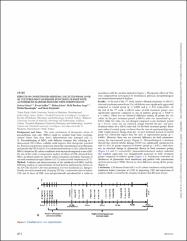Effects of conditioned mediums collected from 2d or 3d cultured mscs on kidney functions of rats with autoimmune diabetes induced with streptozocin

Göster/
Erişim
info:eu-repo/semantics/openAccessTarih
2023Yazar
Özkan, SerbayIşıldar, Başak
Şahin, Hakan
Saygı, Halil İbrahim
Konukoğlu, Dildar
Koyutürk, Meral
Üst veri
Tüm öğe kaydını gösterÖzet
Background and Aims: The main mechanism of therapeutic action of mesenchymal stem cells (MSCs) could be resulted from their secretome content rather than their direct differentiation into damaged cells [1, 2]. Preconditioning of MSCs with different strategies like culturing in 3 dimensional (3D) culture scaffolds could improve their therapeutic potential [1]. Basedonourpreviousstudy[1]inwhichtheconcentrationsoftotalprotein andspecifically VEGFandIL-4inconditionedmediums(CMs)collectedfrom MSCsculturedin3Dcultureconditionswereincreasedcomparedtooneof2D, the aim of this study is comparative analysis of effects of CMs obtained from MSCs incubated under 2D and 3D culture conditions on kidney functions of rats with autoimmunetypeIdiabetes(aT1D)inducedwithstreptozocin(STZ). Method: Isolation and characterization of the umbilical cord MSCs and the following analysis of concentrations of total protein and paracrine factors in the 2D-CMs and 3D-CMs were performed as it was mentioned [1]. SpragueDawleyratsweretreatedwith20mg/kgSTZfor5consecutivedaystoinduce T1D and 12 doses of CMs were intraperitoneally introduced for 4 weeks in accordance with the timeline defined in Figure 1. Therapeutic effects of CMs were comparatively investigated by biochemical, physical, histopathological and immunohistochemical analysis. Results: At the end of the 2nd week, urinary albumin/creatinine (u-Alb/Cr) ratio andcreatinineremovalrate(Crr)ofdiabetesweresignificantlyaggravated compared to control group (p = 0,0001 and p = 0,13 respectively). At the end of the 7th week, u-Alb/Cr ratios of both treatment groups were significantly improved compared to one of diabetes group (p = 0,029 vs p = 0,002). There was no statistical difference among all groups for Crr values. In the post treatment period u-Alb/Cr ratio was exacerbated (p = 0,014) while Crr value was not changed compared to pre-treatment period (p = 0,713). There was no statistical change between the pre- and posttreatment values of u-Alb/Cr ratio and Crr for both treatment groups. Renal mass index of control group was lower than the ones of experimental groups, while weight percent change from pre- to post-treatment period of control group was statistically higher than the ones of experimental groups (p = 0,0001). However, there was no statistical difference for both parameters among the experimental groups (Figure 2). Histopathological evaluations showed that cortical tubular damage (CTD) was significantly ameliorated in only D+3D-CM group compared to diabetes group (p = 0,012), while there was no statistical change in glomerular fibrosis in both treatment groups (Figure 3.1 and 3.2 respectively). Immunohistochemical analysis indicated that nephrin expression was insignificantly increased in both treatment groups compared to diabetes group (Figure 3.3). Preliminary evaluation of thicknesses of glomerular basal membrane and pedicel with transmission electron microscopy (TEM) showed no clear difference among all the groups (Figure 4). Conclusion: CMobtainedfromMSCsin3Dcultureconditionscouldpartially ameliorate kidney functions of aT1D by improving CTD and expression of nephrin which is crucial for the integrity of glomerular filtration barrier.

















